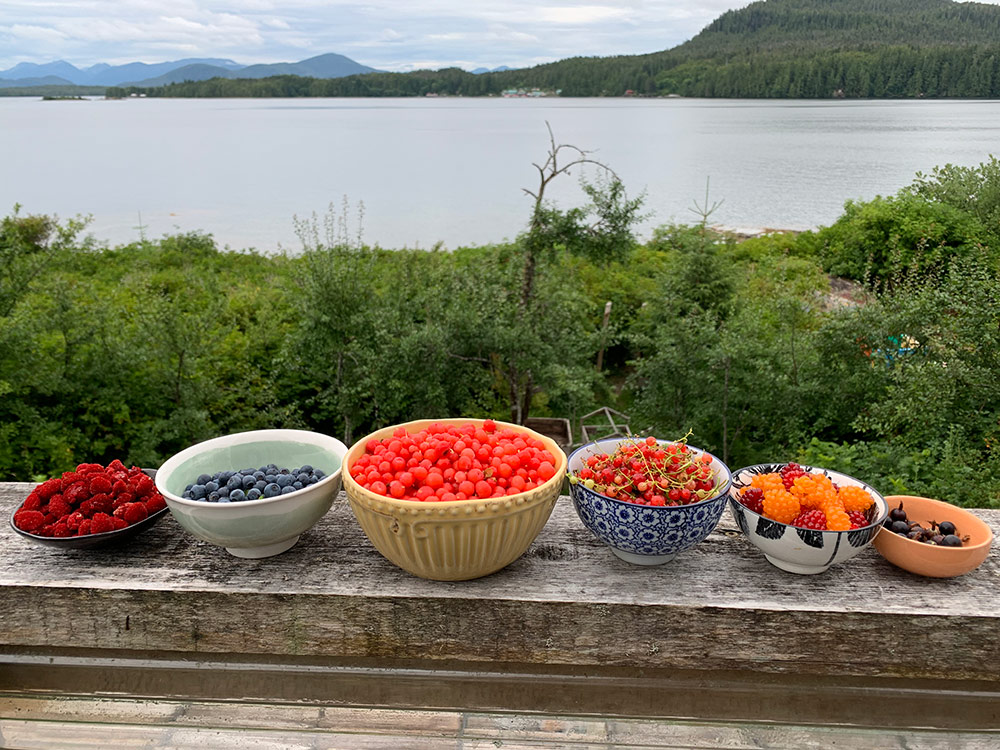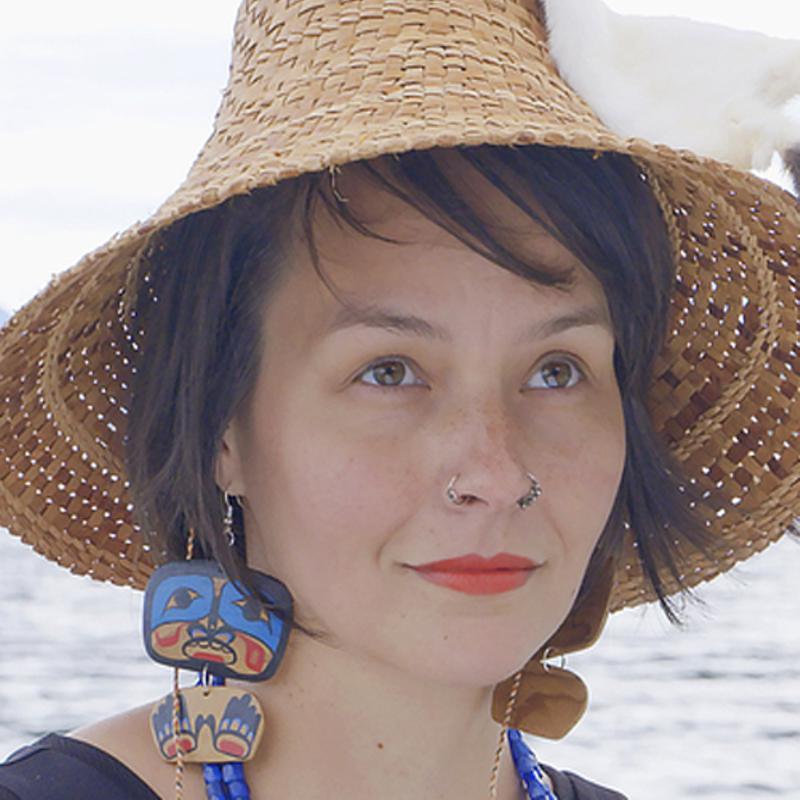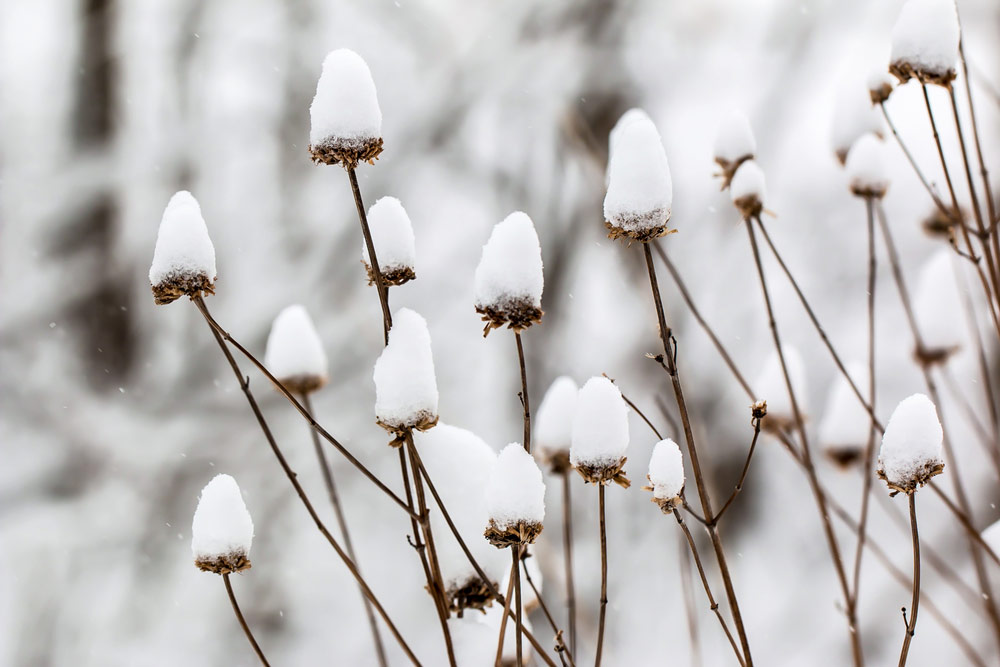It’s December, and the hard frost has finally crusted into my garden beds and transformed the mazes between wild berry bushes in my yard into a beautiful network of ice crystals in the dirt.
Lately, I’ve turned to our stores of preserves to keep our family fed, our dehydrated and frozen stashes of herbs and vegetables diligently harvested by my children over the spring and summer and into the first cool months of fall. It appears that our gardens are at rest now, but I know the deeper work that supports our seasonal thriving is still creating magic in our raised beds; beneath the frost, the layers of kelp mulch and decaying bracken fern, the soil is rebuilding itself with deep inhales of cold winter air.
I live on the outer central coast, where my ancestral motherlands stretch from the mainland through networks of islands to the open ocean. Pre-contact, our Heiltsuk people lived in more than 50 permanent and seasonal villages across over 35,000 square kilometres of land and sea. Now, we are primarily nestled in the community of Bella Bella, facing east from Campbell Island, in a community where nearly half of households are engaged in growing food at their homes and almost every household is engaged in harvesting it out on the territory.
There’s a false belief that gardens can’t thrive here, but I believe in abundance. And much of what I’ve learned about how to nurture plants in this environment comes from watching my non-human kin flourish: grizzly and black bears pulling salmon carcasses into the forest to fertilize the bursting riparian areas, the world shaping itself around the pathways of water, the reciprocity of thinking in whole systems. My ancestors tended root gardens, orchards of wild fruit trees, medicine patches and swaths of berry bushes; they believed in abundance too.
I grew up in a family where self-sufficiency and localized food systems were upheld as an intergenerational ideal, and alongside my parents and grandparents I got to play a role in supporting the food security of my family and our kin by growing gardens and harvesting wild foods — nourishing our spirits in the gathering, and our bodies in the feasting. And now I do this beautiful work alongside my own children, whose small hands gather berries and plant radish seeds and pick peas through the seasons of abundance — small hands that also wait patiently during the seasons of rest.

In my childhood, we spent long days in my grandparents’ backyard cannery, where our whole extended family would gather to process and preserve seasonal harvests. Regardless of what bounty was in front of us, my late grandfather had one unbreakable rule: we waste nothing. When we worked on herring eggs or seaweed, us children would patrol the teeming tables and grade out what was not usable, burying the leftovers deep in the garden beds to break down and enrich the soil once grandpa’s vegetables started growing. Clam and cockle shells were crushed to amend the soil, fish guts were buried by the rhododendron, and even the totes of slimy, bloody water left over from cleaning salmon and halibut were poured across the greenest lawn in Bella Bella. Nourishment was absolute and reciprocal.
Part of what I love about gardening is the ritual: it patterns my year and makes me feel close to people like my grandfather, whose ancient rhubarb plants have been split apart and now grow in my own garden. But I also love the sense of agency it gives me. I can walk the linear path of planting a seed, tending a seedling into a healthy plant and harvesting some small bounty that will feed my loved ones. I can deepen my knowledge of our climate, soil amendment, companion planting and other factors that help my bounty grow. Compared to much of the rest of my life, gardening brings clarity and regularity.
The link between gardening and mental health crystalized for me in 2017 after the previous year’s Nathan E. Stewart oil spill, a devastating disaster in which a U.S.-owned tug and barge ran aground in one of the most sensitive and abundant ecosystems in our homelands. Over 100,000 litres of diesel poured into an area our people formerly referred to as “the breadbasket of our territory,” impacting dozens of marine and intertidal species that hundreds of Heiltsuk families relied on for sustenance.
In the wake of that spill, during which I represented my nation as incident commander, trauma embedded itself into our community. Personally, I struggled to integrate back to normal life after the emergency response phase ended, and I grappled with waves of symptoms that eventually resolved in a diagnosis of post-traumatic stress disorder. At the time my older son was around two, and I was early in my pregnancy with my younger son. As I felt darkness around me, I wanted to believe that I was a seed fighting toward light and air.
What saved me was gardening. We transformed an empty lot across from our office into a community garden, building in flower beds and welcoming features that would make it a peaceful space for Heiltsuk spill responders to rest. We began to offer gardening workshops, using the space to build skills for community members around growing their own food. And the rhythms of being out in the fresh air and putting my hands in the soil helped me to process the deep grief of the spill so I could find a pathway toward wellness again.
We knew that growing carrots and onions could never replace the tainted clam beds or the plethora of ocean relatives that were poisoned by the spill. But it gave me a small sense of stability, control and agency over my family’s food security — enough to help pull me through the worst of the mental and spiritual anguish. And I hope it gave that gift to others too.
Later in 2017, in the depths of autumn, I planted a flower garden for my grandmother. I slowly cleared away evidence of the seasons that had passed since my late grandfather, an avid gardener, had last tended to the raised beds in the backyard — then I topped up the soil and buried hundreds of bulbs in the hope that by May, for my grandmother’s birthday, the beds would be in full bloom. Even as I did that work, part of me wondered if my grandmother — then 90-years-old — would be alive to see the blossoms.
Happily, by her birthday the next spring her house had already seen bouquets of daffodils, whole palettes of tulips, hollyhocks and freesias, gladioluses and more. She kept the labels from the packages of bulbs in the pocket on the side of her recliner and she’d pull out the worn cardboard to read about each flower we cut and brought into her living room. Each spring brought a riot of colourful petals into her living room, and each fall I’d lovingly mulch the beds the way my late grandfather taught me so the soil would be primed to push up another season of blooms when winter passed.
This summer, my grandmother — then 94 — said it was time for the garden to be cleared away. She asked me to unearth the flower bulbs and plant them in my own garden at home. I layered them in sawdust and tucked them out of sight. By October, her health began to fail, and although I was busy tending to her end-of-life care with the rest of my family, it brought me comfort to work in my garden in my spare time to put things to rest. I cut up my kelp and decaying bracken fern to top my beds, planted my garlic, and days before she died, I planted her flower bulbs in a raised bed overlooking the yard where my children play.
Although my grief is profound, I’m comforted imagining those bulbs firmly and safely nestled in the soil beneath layers of mulch and a superficial crust of winter frost. The cycles of my garden have taught me that there are times to rest in the sweetness of grief, to find quiet nourishment in the moments when things are disintegrating all around me — because I’ve learned to trust in my own resilience and in the shoots and blooms I know are coming — after winter, after grief, after the restorative and regenerative period of rest this season calls for.
This is the season of rest and reflection, of deep and often unseen nourishment. So my parting offering is a small meditation: Imagine a radish seed. Imagine its shape, not spherical but a little irregular. Think of its colour, almost like a raw almond. Its size and its weight. Imagine the feel of a single seed dropping into your hand, of several dozen seeds pelting gently onto your flat palm. Imagine teasing one away from the pile and pushing it into soft soil with your fingertip, covering it over again. It’ll unburden itself in the moist darkness, begin to unspool its tender roots, push its stem toward the surface of the soil to seek the light. Imagine those leaves unfurling, those roots swelling into crunchy gems of bright colour waiting to nourish your body. A radish seed wants to grow. It wants to thrive.
Rest your garden; let it regenerate. Rest yourself; you deserve regeneration too. Believe in abundance and rest in the cycles that give structure to our resilience. ![]()
Read more: Indigenous, Health, Food, Environment
















Tyee Commenting Guidelines
Comments that violate guidelines risk being deleted, and violations may result in a temporary or permanent user ban. Maintain the spirit of good conversation to stay in the discussion and be patient with moderators. Comments are reviewed regularly but not in real time.
Do:
Do not: